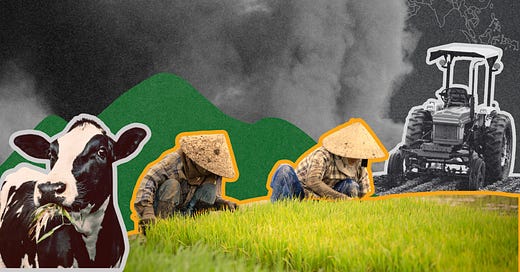Asia’s Agriculture: A Lifeline for Millions or A Climate Liability?
More than 2.2 billion people in Asia rely on agriculture for their livelihoods, making it a cornerstone of the region's economy and society. However, this dependence comes with significant environmental costs. Asia and the Pacific contribute 37% of the world's total emissions from agricultural production, with the People's Republic of China alone accounting for more than 18% of these emissions. Additionally, agriculture is the largest consumer of water in most Asian countries, using up to 90% of total water resources.
Agriculture and land use are major sources of greenhouse gas emissions in Asia, driven by several interconnected factors. Deforestation and land-use changes are among the leading contributors. The expansion of agricultural land for crops like palm oil and rubber drives large-scale deforestation, particularly in Southeast Asia, where nearly two-thirds of forest loss is attributed to commodity-driven activities. This results in the loss of critical carbon sinks, significantly increasing carbon dioxide emissions.
Subscribed
Rice cultivation, a staple agricultural activity in Asia, is another significant source of emissions. Traditional flooded rice paddies create anaerobic conditions that generate methane, a greenhouse gas with a global warming potential 25 times greater than carbon dioxide. As Asia produces 90% of the world’s rice, the region accounts for a substantial portion of global methane emissions from agriculture.
The overuse of chemical fertilizers exacerbates the problem. Farmers across Asia heavily rely on nitrogen-based fertilizers to boost yields, but excessive application leads to emissions of nitrous oxide, a greenhouse gas that is 298 times more potent than carbon dioxide. This practice not only increases emissions but also degrades soil health, threatening long-term agricultural sustainability.
Livestock farming contributes further to the region’s emissions profile. The growing demand for meat and dairy products has led to increased livestock populations, which emit methane through enteric fermentation and manure management. Southeast Asia alone accounts for 40% of global methane emissions from livestock, underscoring the scale of the challenge.
Food loss and waste also play a critical role in agricultural emissions. Inefficient supply chains, poor storage infrastructure, and consumer waste result in significant food wastage. When this waste decomposes in landfills, it produces methane, adding to the emissions burden. Globally, food loss and waste contribute 8-10% of annual greenhouse gas emissions, with Asia being a key contributor due to its massive population and food systems.
Solutions
There is no silver bullet for any of the high-emitting sectors in this article, but there is potential for a few solutions that could significantly reduce the majority of emissions Asian countries currently face.
One of them is cultivated meat. This technology offers a much more sustainable alternative. A life cycle assessment published in 2021 found that cultivated meat could reduce up to 92% of greenhouse gas emissions, 95% of land use, and 78% of water use compared to conventional beef production. This makes it a game-changer in addressing the environmental toll of traditional farming practices.
Traditional livestock farming significantly contributes to greenhouse gas emissions, deforestation, and water pollution. Cattle alone are responsible for around 62% of global livestock emissions, largely due to methane released during digestion. Additionally, producing a single calorie of beef requires approximately 100 calories of feed, meaning our cattle alone consume a food load that is equal to the caloric needs of 8.7 billion people – more than the entire world population in 2024.
Earth Venture Capital invested in a startup called Orbillion. They are leading the charge in the cultivated meat industry with its mission to create sustainable, nutritious, and flavorful meat at price parity with conventional meat. The company focuses on the global ground beef market and specializes in premium products like Wagyu beef.
Another potential solution is from bio-compostable materials. The food manufacturing industry generates millions of tons of organic waste annually, much of which goes underutilized, while the agricultural sector produces at least 1,300 million tons of residue waste each year—a figure set to grow as the global population increases. Our current linear approach to managing this waste, primarily through landfills and incineration, contributes approximately 3% of global greenhouse gas emissions.
Addressing this issue is Alterpacks, a Singapore-based company transforming organic plant-fiber waste into 100% bio-compostable packaging materials. Alterpacks' innovative approach not only upcycles agricultural waste into environmentally responsible products but also provides cost-effective, high-performing alternatives to plastic packaging. Their solutions have the potential to revolutionize multiple industries, including food and beverage, cosmetics, packaging, and fashion, making them a pivotal player in the fight against plastic pollution and waste mismanagement.
Closing
Blaming each other for global emissions has become a common narrative between nations. The West accuses the East of unchecked industrialization, while the East counters that the West industrialized without emission constraints and now hinders other countries’ development, all while maintaining a much higher lifestyle-based carbon footprint compared to the East’s emissions needed for basic survival.
The solution, while simple in principle, is far from easy—everyone must do everything within their power. Earth Venture Capital is embracing this challenge with its Fund II, focusing on three critical sectors: Energy Transition, Sustainable Manufacturing, and Land-use & Agriculture. Our mission is to invest in global solutions that not only improve existing technologies but also significantly reduce or eliminate greenhouse gas altogether.
Subscribed
Share
Previous




